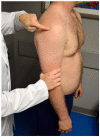Comprehensive Examination of the Athlete's Shoulder
- PMID: 29443643
- PMCID: PMC6044121
- DOI: 10.1177/1941738118757197
Comprehensive Examination of the Athlete's Shoulder
Abstract
Context: Shoulder pain and dysfunction are common, with patients presenting complaints to both primary and orthopaedic physicians. History and physical examination remain essential to creating a differential diagnosis, even as noninvasive imaging has improved.
Evidence acquisition: Literature was obtained through keyword searches based on the pathology in question (eg, rotator cuff) and the keywords physical examination using PubMed from January 1, 1980, through September 20, 2017. Additional evidence was obtained through screening references from articles identified through the PubMed searches.
Study design: Clinical review.
Level of evidence: Level 3.
Results: A total of 7817 articles were screened for relevance. Several physical examination maneuvers have been described for each specific pathology. The Neer sign has a 75% sensitivity for subacromial impingement (SAI), while the Hawkins-Kennedy test has an 80% sensitivity. The painful arc test has an 80% specificity for SAI. The apprehension test has a hazard ratio of 2.96 for anterior shoulder instability. The Jobe test has a sensitivity of 52.6% and a specificity of 82.4% for full-thickness supraspinatus tears, confirmed on arthroscopy. The lag sign is highly sensitive and specific for combined full-thickness supraspinatus and infraspinatus tears at 97% and 93%, respectively. The Speed test has a sensitivity of 54% and specificity of 81% for biceps pathology. The anterior slide test and O'Brien active compression test have been described for superior labrum anterior posterior tears with inconsistent reliability. The cross-body adduction test has a sensitivity of 77% and a specificity of 79% for acromioclavicular joint pathology.
Conclusion: Several physical examination maneuvers can isolate specific pathology of the shoulder, with widely ranging sensitivity and specificity.
Keywords: acromioclavicular joint; biceps; glenoid labrum; physical examination; rotator cuff; shoulder.
Conflict of interest statement
The following author declared potential conflicts of interest: Bernard R. Bach Jr, MD, receives royalties from SLACK Inc and research support from Tornier, Arthrex Inc, CONMED Linvatec, DJ Orthopaedics, Ossur, and Smith & Nephew.
Figures










References
-
- Andrews JR, Wilcox CL. Decision making in the throwing athlete. Sports Med Arthrosc. 2014;22:130-136. - PubMed
-
- Bahk M, Keyurapan E, Tasaki A, Sauers EL, McFarland EG. Laxity testing of the shoulder: a review. Am J Sports Med. 2007;35:131-144. - PubMed
-
- Bartsch M, Greiner S, Haas NP, Scheibel M. Diagnostic values of clinical tests for subscapularis lesions. Knee Surg Sports Traumatol Arthrosc. 2010;18:1712-1717. - PubMed
-
- Beighton P. Hypermobility scoring. Br J Rheumatol. 1988;27:163. - PubMed
Publication types
MeSH terms
LinkOut - more resources
Full Text Sources
Other Literature Sources
Medical
Research Materials

